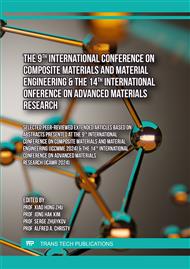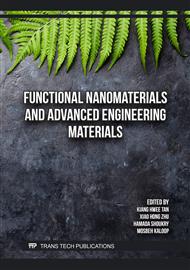[1]
K. Yorseng, S. M. Rangappa, H. Pulikkalparambil, S. Siengchin und J. Parameswaranpillai, "Accelerated weathering studies of kenaf/sisal fiber fabric reinforced fully biobased hybrid bioepoxy composites for semi-structural applications: Morphology, thermo-mechanical, water absorption behavior and surface hydrophobicity," Construction and Building Materials, Bd. 235, 2020.
DOI: 10.1016/j.conbuildmat.2019.117464
Google Scholar
[2]
G. Pitarresi, D. Tumino und A. Mancuso, "Thermo-Mechanical Behaviour of Flax-Fibre Reinforced Epoxy Laminates for Industrial Applications," Materials, Bd. 8, Nr. 11, 2015.
DOI: 10.3390/ma8115384
Google Scholar
[3]
B. Barari, E. Omrani, A. D. Moghadam, P. L. Menezes, K. M. Pillai und P. K. Rohatgi, "Mechanical, physical and tribological characterization of nano-cellulose fibers reinforced bio-epoxy composites: An attempt to fabricate and scale the 'Green' composite," Carbohydrate Polymers, Bd. 147, pp.282-293, 2016.
DOI: 10.1016/j.carbpol.2016.03.097
Google Scholar
[4]
A. Ajithram, J. W. Jappes, S. D. Kumar und G. Chithra, "Water hyacinth plant powder particle with moringa filler powder reinforced epoxy polymer composite absorption properties," Materialstoday: Proceedings, 2023.
DOI: 10.1016/j.matpr.2023.01.156
Google Scholar
[5]
S. Chonsakorn, S. Srivorradatpaisan und R. Mongkholrattanasit, "Effects of different extraction methods on some properties of water hyacinth fiber," Journal of Natural Fibers , Bd. 16, Nr. 7, 2019.
DOI: 10.1080/15440478.2018.1448316
Google Scholar
[6]
A. Ajithram, J. W. Jappes, I. Siva und N. Brintha, "Utilizing the aquatic waste and investigation on water hyacinth (Eichhornia crassipes) natural plant in to the fibre composite: Waste recycling," Materialstoday: Proceedings, Bde. %1 von %258-3, pp.953-958, 2022.
DOI: 10.1016/j.matpr.2022.02.301
Google Scholar
[7]
C. M. Vu, D. D. Nguyen, L. H. Sinh, T. D. Pham, L. T. Pham und H. J. Choi, "Environmentally benign green composites based on epoxy resin/bacterial cellulose reinforced glass fiber: Fabrication and mechanical characteristics," Polymer Testing, Bd. 61, pp.150-161, 2017.
DOI: 10.1016/j.polymertesting.2017.05.013
Google Scholar
[8]
K. Yorseng, S. M. Rangappa, J. Parameswaranpillai und S. Siengchin, "Towards green composites: Bioepoxy composites reinforced with bamboo/basalt/carbon fabrics," Journal of Cleaner Production, Bd. 363, 2022.
DOI: 10.1016/j.jclepro.2022.132314
Google Scholar
[9]
J.-W. Rhim, H.-M. Park und C.-S. Ha, "Bio-nanocomposites for food packaging applications," Progress in Polymer Science, Bd. 38, Nr. 10-11, pp.1629-1652, 2013.
DOI: 10.1016/j.progpolymsci.2013.05.008
Google Scholar
[10]
T. Padmavathi, S. V. Naidu und R. Rao, "Studies on Mechanical Behavior of Surface Modified Sisal Fibre – Epoxy Composites," Journal of Reinforced Plastics and Composites, Bd. 31, Nr. 8, 2012.
DOI: 10.1177/0731684412438954
Google Scholar
[11]
Z. Khan, B. Yousif und M. Islam, "Fracture behaviour of bamboo fiber reinforced epoxy composites," Composites Part B: Engineering, Bd. 116, pp.186-199, 2017.
DOI: 10.1016/j.compositesb.2017.02.015
Google Scholar
[12]
N. Sgriccia, M. Hawley und M. Misra, "Characterization of natural fiber surfaces and natural fiber composites," Composites Part A: Applied Science and Manufacturing, Bd. 39, Nr. 10, pp.1632-1637, 2008.
DOI: 10.1016/j.compositesa.2008.07.007
Google Scholar
[13]
N. F. Ramirez, Y. S. Hernandez, J. C. d. Leon, S. V. Garcia, L. D. Lvova und L. G. Gonzalez, "Composites from water hyacinth (Eichhornea crassipe) and polyester resin," Fibers and Polymers , Bd. 16, pp.196-200, 2015.
DOI: 10.1007/s12221-015-0196-5
Google Scholar
[14]
S.-K. Yeh, C.-R. Hu, M. B. Rizkiana und C.-H. Kuo, "Effect of fiber size, cyclic moisture absorption and fungal decay on the durability of natural fiber composites," Construction and Building Materials, Bd. 286, 2021.
DOI: 10.1016/j.conbuildmat.2021.122819
Google Scholar
[15]
S. Sulardjaka, N. Iskandar, S. Nugroho, A. Alamsyah und A. Prasetya, "The characterization of unidirectional and woven water hyacinth fiber reinforced with epoxy resin composites," Heliyon, Bd. 8, 2022.
DOI: 10.1016/j.heliyon.2022.e10484
Google Scholar
[16]
S. Adil, B. Kumar, P. S. Panicker, D. H. Pham und J. Kim, "High-performance green composites made by cellulose long filament-reinforced vanillin epoxy resin," Polymer Testing, Nr. 123, 2023.
DOI: 10.1016/j.polymertesting.2023.108042
Google Scholar
[17]
R. Girimurugan, R. Pugazhenthi, P. Maheskumar, T. Suresh und M. Vairavel, "Impact and hardness behaviour of epoxy resin matrix composites reinforced with banana fiber/camellia sinensis particles," Material today: proceedings, Nr. 39, pp.373-377, 2021.
DOI: 10.1016/j.matpr.2020.07.597
Google Scholar
[18]
G. Bansal, A. Roy, S. Panwar, A. Ghanata und R. Taluja, "Rockwell hardness and izod impact characterization of chicken feather fiber reinforced epoxy composite," International Journal of Engineering Technology Science and Research, Bd. 5, Nr. 3, 2018.
Google Scholar



